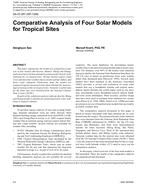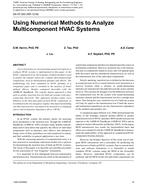-
-
Available Formats
- Options
- Availability
- Priced From ( in USD )
-
Available Formats
-
- Immediate download
- $16.00
- Add to Cart
Customers Who Bought This Also Bought
-

DA-07-023 Prediction of Distributed Air Leakage in Raised...
Priced From $16.00 -

DA-07-063 New Procedure for Estimating Seasonal Energy Ef...
Priced From $16.00 -

DA-07-057 Comparative Analysis of Four Solar Models for T...
Priced From $0.00 -

DA-07-042 Numerical Study of Air Movement in a Slot-Venti...
Priced From $16.00
About This Item
Full Description
A two-tiered process incorporating numerical analysis to evaluate HVAC systems is implemented in this paper. At the HVAC component level, the boundary element method is used to predict the transfer matrix for complex three-dimensional components, such as lined/unlined plenums and elbows. The methodology has been validated on HVAC plenums in a companion paper and is extended to the analysis of lined/ unlined elbows. Results compared favorably with the ASHRAE Handbook. The transfer matrix approach is then used to predict insertion loss for built-up systems with interconnecting ductwork. This approach assumes plane wave behavior at the inlet and outlet of each HVAC component, so it is limited to the low-frequency regime. One important finding was that insertion loss was found to be insensitive to changing source and termination impedance above 200 Hz.
Units: Dual





